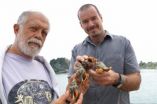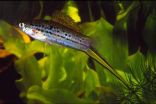(Press-News.org) As climate change shifts the geographic ranges in which animals can be found, concern mounts over the effect it has on their parasites. Does an increased range for a host mean new territory for its parasites as well?
Not necessarily, says a team of UC Santa Barbara scientists, including parasitologists Ryan Hechinger and Armand Kuris. In a study published in the Journal of Biogeography, Hechinger, Kuris and colleagues show that for some species, the opposite may happen: Hosts may actually lose their parasites when the hosts shift or increase their range. Theirs is one of very few studies that examine the effects of climate change on the lives of often overlooked — but nonetheless significant — parasite populations. Also contributing to the paper as lead author is Julie Hopper, now a Ph.D. student at UC Berkeley. Hopper was a student at UCSB when the research was conducted.
"We asked the question: Do hosts that have expanded their range escape their parasites?" said Hopper. The researchers predicted that they might, given previous findings that invasive species — species that have also increased their range, but to areas not geographically connected to their historic ranges — tend to escape their parasites.
"Invasive species escape parasites for several reasons," said Hechinger, an associate research biologist/professor at UCSB and Scripps Institute of Oceanography. "Many parasites do not come with the invader to begin with — they miss the boat." He added that many parasites that accompany their invasive host do not persist because the parasites, many of which live parts of their life cycles in different hosts, no longer have access to the environments or other hosts required to complete their life cycles. On top of this loss of parasites, invasive hosts do not acquire many new ones in their invasive ranges, which explains the hosts' overall escape from parasites.
But what happens when a species expands its range by moving into an adjoining area?
"People have barely looked at this, and never before in the ocean," said Hechinger.
To answer their question, the researchers studied Kellet's whelk, a large marine snail whose historical biogeographical range starts at mid-Baja California waters in the south to Point Conception in the north. For the last couple of decades, due to the gradual warming of the ocean, the whelks have been moving their boundaries north into what used to be cooler waters. Now they can be found as far north as Monterey.
The whelks are important players in kelp forest food webs. The whelks are also a delicacy and there is a growing appetite for them in southern California. Despite this importance, there have been no previous studies of parasites or infectious disease in the whelks, much less a study examining whether they have escaped parasites in their expanded range.
However, according to the researchers' parasitological examination of whelks throughout their historical and expanded ranges, those living beyond their historic Point Conception boundary have neither the amount nor the diversity of parasites that infect their southern counterparts, despite the relative proximity of their historical range.
The researchers suspect that the northern whelks have escaped their parasites for several reasons. One factor, said Hechinger, is that the southern California whelks do not crawl around much. "It's not as if infected snails are going to move miles, wander around Point Conception, and bring their parasites to the expanded range," he said.
The whelks that are now found north of the boundary are ones that dispersed into the area during their planktonic larval stage. These juvenile stages do not serve as hosts for the parasites that infect juvenile and adult whelks. "So we know that the northern populations 'started clean,'" explained Hechinger. Those whelks would be free of the parasites they would acquire in the south as they mature.
But the parasite escape is still somewhat surprising when considering the types of parasites that infect the whelks. "We discovered that the whelks are mostly intermediate hosts for tapeworms and roundworms said Hopper. "These parasites eventually end up maturing and reproducing in sharks and rays."
"These sharks and rays, they can move around," said Hechinger. "And they should be able to move the parasites around. It's been a few decades since the whelks moved up north. Why haven't sharks and rays brought parasites from south to north to let the parasites catch up with the whelks?"
A likely reason is a phenomenon called "site fidelity."
"It turns out that many of the sharks and rays that are potential hosts for the whelk parasites do not move up and down the coast a lot," said Hechinger. Thus, although free to wander, the sharks and rays likely do not regularly make the trek from southern to northern California.
"Also important is that the hosts in the expanded range are at lower densities than in the historical range so, even if some parasites got to the north, it's hard for them to be transmitted under those conditions," said Kuris, UCSB professor of zoology.
According to Hechinger and Kuris, the evidence from this study suggests that perceived fallout from global warming — in terms of the fears of the spread of infectious disease associated with global warming-induced range expansions — is not as foregone a conclusion as many may think. At least for marine parasites such as the ones that live in the Kellet's whelk, the evidence indicates that range expansion for the host does not mean the same for its parasites.
In fact, a trend of parasite escape for expanded-range species might signal a different phenomenon altogether: the spread of host species that are missing their natural enemies and are thus not as impacted by parasites as they would be in their natural, historical environments. It's a phenomenon that happens with invasive species that escape their parasites. "Invasive species perform better without the constant drain imposed on them by parasites," said Kuris. This "release" from natural enemies can lead to invasives causing major shifts in the ecology of the new environment, which can be extremely benign for invasive species.
However, unlike for invasive species, "expanded ranges may be no Gardens of Eden," notes Hechinger. For instance, in the case of the whelks, nature still manages to check their northern populations because the environment is still not as optimal as their historical range. In fact, the escape of parasites may be the factor that allows them to survive at all.
While parasite escape might be a general trend for host populations shifting their ranges — and many populations are shifting poleward because of global warming — there is currently only a scant amount of data on the phenomenon. The researchers are aware of only one other similar study on a caterpillar in the United Kingdom, and hope that further investigations into parasitism in other poleward-expanding species can shed more light on the situation.
"Is it largely population size, extreme environmental conditions or availability of all the hosts in a life cycle that reduce the abundance of parasites in
expanded parts of the range?" asked Kuris. "Do we ever begin to see amplification of a parasite and spread to other hosts? As more investigations happen it will be interesting to discover the mechanisms and the general role of parasites in range expansions."
Graduate student researcher Julio Lorda, contributed to the study, as did Sara Simmonds and Crow White, who were also graduate students at the time of the research.
INFORMATION: END
Not at home on the range
A new study on parasites that infect a marine snail suggests that though hosts might expand their geographical range, the parasites don't always follow
2014-07-09
ELSE PRESS RELEASES FROM THIS DATE:
New system would give individuals more control over shared digital data
2014-07-09
Cellphone metadata has been in the news quite a bit lately, but the National Security Agency isn't the only organization that collects information about people's online behavior. Newly downloaded cellphone apps routinely ask to access your location information, your address book, or other apps, and of course, websites like Amazon or Netflix track your browsing history in the interest of making personalized recommendations.
At the same time, a host of recent studies have demonstrated that it's shockingly easy to identify unnamed individuals in supposedly "anonymized" data ...
NASA, NOAA satellites help confirm Tropical Storm Fausto as a remnant low
2014-07-09
NOAA's GOES-West and NASA-JAXA's Global Precipitation Measurement or GPM mission satellite helped forecasters at the National Hurricane Center determine that what was once Tropical Storm Fausto is now a remnant area of low pressure in the Eastern Pacific Ocean.
Forecaster Beven at the National Hurricane Center (NHC) noted that "satellite imagery, overnight scatterometer data, and a recent GPM satellite microwave overpass indicate that Fausto has degenerated to a trough of low pressure."
On July 9 at 1500 UTC (11 a.m. EDT) Fausto's circulation was no longer apparent ...
Study identifies novel genomic changes in the most common type of lung cancer
2014-07-09
Researchers from The Cancer Genome Atlas (TCGA) Research Network have identified novel mutations in a well-known cancer-causing pathway in lung adenocarcinoma, the most common subtype of lung cancer. Knowledge of these genomic changes may expand the number of possible therapeutic targets for this disease and potentially identify a greater number of patients with treatable mutations because many potent cancer drugs that target these mutations already exist.
TCGA is jointly funded and managed by the National Cancer Institute (NCI) and the National Human Genome Research ...
Study cracks how the brain processes emotions
2014-07-09
ITHACA, N.Y. – Although feelings are personal and subjective, the human brain turns them into a standard code that objectively represents emotions across different senses, situations and even people, reports a new study by Cornell University neuroscientist Adam Anderson.
"We discovered that fine-grained patterns of neural activity within the orbitofrontal cortex, an area of the brain associated with emotional processing, act as a neural code which captures an individual's subjective feeling," says Anderson, associate professor of human development in Cornell's College ...
Bacteria hijack plentiful iron supply source to flourish
2014-07-09
In an era of increasing concern about the prevalence of antibiotic-resistant illness, Case Western Reserve researchers have identified a promising new pathway to disabling disease: blocking bacteria's access to iron in the body.
The scientists showed how bacterial siderophore, a small molecule, captures iron from two abundant supply sources to fan bacterial growth — as well as how the body launches a chemical counterassault against this infection process. Their findings appear in a recent edition of The Journal of Experimental Medicine.
"Bacterial siderophore will be ...
Climate change provides good growing conditions for charcoal rot in soybeans
2014-07-09
URBANA, Ill. – With over 100 diseases that can attack soybean crops, why would charcoal rot rise to the top of the most wanted list? University of Illinois scientists cite the earth's changing climate as one reason that more research is needed on the fungus that causes charcoal rot.
Fungi may often be associated with cool, damp growing conditions but Macrophomina phaseolina, the fungus that causes charcoal rot, prefers hot and dry drought conditions.
"As the climate continues to change and we see more extremes in the weather, including hotter, drier summers, this fungus ...
Biologists link sexual selection and placenta formation
2014-07-09
RIVERSIDE, Calif. — Sexual selection refers to species' selection for traits that are attractive to the opposite sex. This special type of natural selection enhances opportunities to mate, the tail of male peacocks being an iconic example.
Biologists at the University of California, Riverside have now found that sexual selection and "placentation" — the formation of a placenta — are linked. Describing the life histories of more than 150 species of fish in the family Poeciliidae, the researchers found that species with placentas tend to have males that do not have bright ...
USF study: Amphibians can acquire resistance to deadly fungus
2014-07-09
Tampa, Fla. (July 9, 2014) – Emerging fungal pathogens pose a greater threat to biodiversity than any other parasitic group, causing population declines of amphibians, bats, corals, bees and snakes. New research from the University of South Florida published in the prestigious journal Nature reveals that amphibians can acquire behavioral or immunological resistance to a deadly chytrid fungus implicated in global amphibian population declines.
"Acquired resistance is important because it is the basis of vaccination campaigns based on 'herd immunity', where immunization ...
Fox Chase researchers recommend updating the staging criteria for breast cancer diagnoses
2014-07-09
New findings from Fox Chase Cancer Center paint a relatively optimistic picture of women's chances of surviving a subset of breast cancers that have spread to the chest wall or skin, but not beyond.
Tumors that grow into the skin, regardless of size and whether they have involved lymph nodes, are automatically classified as stage III – and called "locally advanced" tumors, suggesting that they are a relatively serious form of cancer, often with poor survival. Locally advanced breast cancers of this and other types account for five to ten percent of new breast cancer ...
MyChart use skyrocketing among cancer patients, UT Southwestern study finds
2014-07-09
DALLAS – July 9, 2014 – There has been a sharp increase in the number of cancer patients at UT Southwestern Medical Center using MyChart, the online, interactive service that allows patients to view laboratory and radiology results, communicate with their healthcare providers, schedule appointments, and renew prescriptions.
Over a six-year period, the number of patients actively using MyChart each year increased five-fold, while the number of total logins each year increased more than 10-fold, according to a study by Dr. David Gerber, Associate Professor of Internal Medicine, ...
LAST 30 PRESS RELEASES:
Kids’ behavioral health is a growing share of family health costs
Day & night: Cancer disrupts the brain’s natural rhythm
COVID-19 vaccination significantly reduces risk to pregnant women and baby
The role of vaccination in maternal and perinatal outcomes associated with COVID-19 in pregnancy
Mayo Clinic smartwatch system helps parents shorten and defuse children's severe tantrums early
Behavioral health spending spikes to 40% of all children’s health expenditures, nearly doubling in a decade
Digital cognitive behavioral treatment for generalized anxiety disorder
Expenditures for pediatric behavioral health care over time and estimated family financial burden
Air conditioning in nursing homes and mortality during extreme heat
The Alps to lose a record number of glaciers in the next decade
What makes a good proton conductor?
New science reporting guide published for journalists in Bulgaria
New international study reveals major survival gaps among children with cancer
New science reporting guide published for journalists in Turkey
Scientists develop a smarter mRNA therapy that knows which cells to target
Neuroanatomy-informed brain–machine hybrid intelligence for robust acoustic target detection
Eight SwRI hydrogen projects funded by ENERGYWERX
The Lundquist Institute and its start-up company Vitalex Biosciences Announces Strategic Advancement of Second-Generation fungal Vaccine VXV-01 through Phase 1 Trials under $40 Million Competitive Con
Fine particles in pollution are associated with early signs of autoimmune disease
Review article | Towards a Global Ground-Based Earth Observatory (GGBEO): Leveraging existing systems and networks
Penn and UMich create world’s smallest programmable, autonomous robots
Cleveland researchers launch first major study to address ‘hidden performance killer’ in athletes
To connect across politics, try saying what you oppose
Modulating key interaction prevents virus from entering cells
Project explores barriers to NHS career progression facing international medical graduates
Jeonbuk National University researchers explore the impact of different seasonings on the flavor perception of Doenjang soup
Two Keck Medicine of USC Hospitals named Leapfrog Top Teaching Hospitals
World-first discovery uncovers how glioblastoma tumours dodge chemotherapy, potentially opening the door to new treatments
A fatal mix-up: How certain gut bacteria drive multiple sclerosis
New AI tool identifies not just genetic mutations, but the diseases they may cause
[Press-News.org] Not at home on the rangeA new study on parasites that infect a marine snail suggests that though hosts might expand their geographical range, the parasites don't always follow








